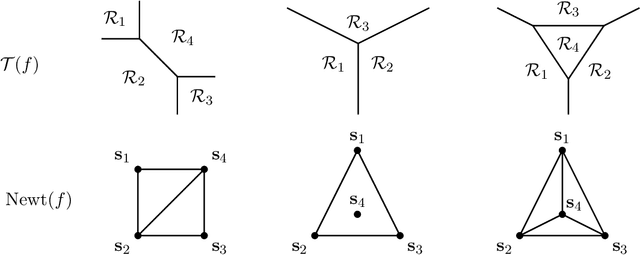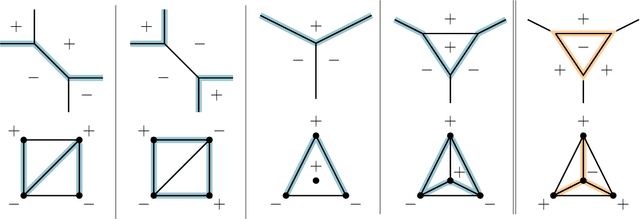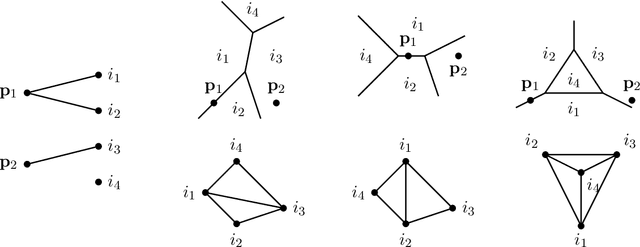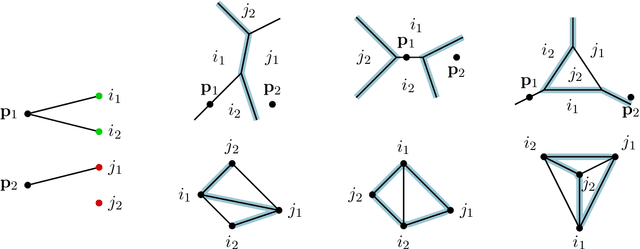Georg Loho
Depth-Bounds for Neural Networks via the Braid Arrangement
Feb 13, 2025Abstract:We contribute towards resolving the open question of how many hidden layers are required in ReLU networks for exactly representing all continuous and piecewise linear functions on $\mathbb{R}^d$. While the question has been resolved in special cases, the best known lower bound in general is still 2. We focus on neural networks that are compatible with certain polyhedral complexes, more precisely with the braid fan. For such neural networks, we prove a non-constant lower bound of $\Omega(\log\log d)$ hidden layers required to exactly represent the maximum of $d$ numbers. Additionally, under our assumption, we provide a combinatorial proof that 3 hidden layers are necessary to compute the maximum of 5 numbers; this had only been verified with an excessive computation so far. Finally, we show that a natural generalization of the best known upper bound to maxout networks is not tight, by demonstrating that a rank-3 maxout layer followed by a rank-2 maxout layer is sufficient to represent the maximum of 7 numbers.
Neural Networks and (Virtual) Extended Formulations
Nov 05, 2024Abstract:Neural networks with piecewise linear activation functions, such as rectified linear units (ReLU) or maxout, are among the most fundamental models in modern machine learning. We make a step towards proving lower bounds on the size of such neural networks by linking their representative capabilities to the notion of the extension complexity $\mathrm{xc}(P)$ of a polytope $P$, a well-studied quantity in combinatorial optimization and polyhedral geometry. To this end, we propose the notion of virtual extension complexity $\mathrm{vxc}(P)=\min\{\mathrm{xc}(Q)+\mathrm{xc}(R)\mid P+Q=R\}$. This generalizes $\mathrm{xc}(P)$ and describes the number of inequalities needed to represent the linear optimization problem over $P$ as a difference of two linear programs. We prove that $\mathrm{vxc}(P)$ is a lower bound on the size of a neural network that optimizes over $P$. While it remains open to derive strong lower bounds on virtual extension complexity, we show that powerful results on the ordinary extension complexity can be converted into lower bounds for monotone neural networks, that is, neural networks with only nonnegative weights. Furthermore, we show that one can efficiently optimize over a polytope $P$ using a small virtual extended formulation. We therefore believe that virtual extension complexity deserves to be studied independently from neural networks, just like the ordinary extension complexity. As a first step in this direction, we derive an example showing that extension complexity can go down under Minkowski sum.
The Real Tropical Geometry of Neural Networks
Mar 18, 2024



Abstract:We consider a binary classifier defined as the sign of a tropical rational function, that is, as the difference of two convex piecewise linear functions. The parameter space of ReLU neural networks is contained as a semialgebraic set inside the parameter space of tropical rational functions. We initiate the study of two different subdivisions of this parameter space: a subdivision into semialgebraic sets, on which the combinatorial type of the decision boundary is fixed, and a subdivision into a polyhedral fan, capturing the combinatorics of the partitions of the dataset. The sublevel sets of the 0/1-loss function arise as subfans of this classification fan, and we show that the level-sets are not necessarily connected. We describe the classification fan i) geometrically, as normal fan of the activation polytope, and ii) combinatorially through a list of properties of associated bipartite graphs, in analogy to covector axioms of oriented matroids and tropical oriented matroids. Our findings extend and refine the connection between neural networks and tropical geometry by observing structures established in real tropical geometry, such as positive tropicalizations of hypersurfaces and tropical semialgebraic sets.
Lower Bounds on the Depth of Integral ReLU Neural Networks via Lattice Polytopes
Feb 24, 2023Abstract:We prove that the set of functions representable by ReLU neural networks with integer weights strictly increases with the network depth while allowing arbitrary width. More precisely, we show that $\lceil\log_2(n)\rceil$ hidden layers are indeed necessary to compute the maximum of $n$ numbers, matching known upper bounds. Our results are based on the known duality between neural networks and Newton polytopes via tropical geometry. The integrality assumption implies that these Newton polytopes are lattice polytopes. Then, our depth lower bounds follow from a parity argument on the normalized volume of faces of such polytopes.
 Add to Chrome
Add to Chrome Add to Firefox
Add to Firefox Add to Edge
Add to Edge